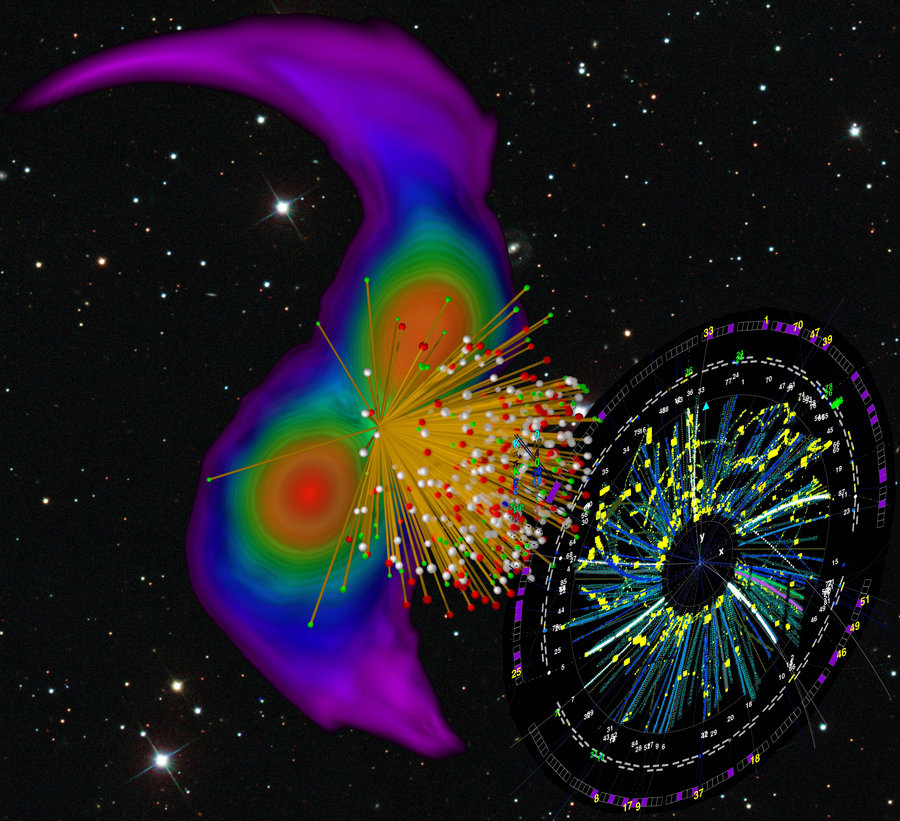attempto online
13.06.2022
New insights into neutron star matter
Combining heavy-ion experiments, astrophysical observations, and nuclear theory
An international research team, including a physicist from the University of Tübingen, has for the first time combined data from heavy-ion experiments, gravitational wave measurements and other astronomical observations using advanced theoretical modelling to more precisely constrain the properties of nuclear matter as it can be found in the interior of neutron stars. The results were published in the journal Nature.
Throughout the Universe, neutron stars are born in supernova explosions that mark the end of the life of massive stars. Sometimes neutron stars are bound in binary systems and will eventually collide with each other. These high-energy, astrophysical phenomena feature such extreme conditions that they produce most of the heavy elements, such as silver and gold. Consequently, neutron stars and their collisions are unique laboratories to study the properties of matter at densities far beyond the densities inside atomic nuclei. Heavy-ion collision experiments conducted with particle accelerators are a complementary way to produce and probe matter at high densities and under extreme conditions.
“Combining knowledge from nuclear theory, nuclear experiment, and astrophysical observations is essential to shedding light on the properties of neutron-rich matter over the entire density range probed in neutron stars,” said Sabrina Huth from Institute of Nuclear Physics at Technical University Darmstadt, who is one of the lead authors of the publication. Peter T. H. Pang, another lead author from the Institute for Gravitational and Subatomic Physics (GRASP), Utrecht University, added, “We find that constraints from collisions of gold ions with particle accelerators show a remarkable consistency with astrophysical observations even though they are obtained with completely different methods.”
Interdisciplinary effort
Recent progress in multi-messenger astronomy allowed the international research team, involving researchers from Germany, the Netherlands, the US, and Sweden to gain new insights to the fundamental interactions at play in nuclear matter. In an interdisciplinary effort, the researchers included information obtained in heavy-ion collisions into a framework combining astronomical observations of electromagnetic signals, measurements of gravitational waves, and high-performance astrophysics computations with theoretical nuclear physics calculations. Their systematic study combines all these individual disciplines for the first time, pointing to a higher pressure at intermediate densities in neutron stars.
The authors incorporated the information from gold-ion collision experiments performed at GSI Helmholtzzentrum für Schwerionenforschung in Darmstadt as well as at Brookhaven National Laboratory and Lawrence Berkeley National Laboratory in the USA in their multi-step procedure that analyzes constraints from nuclear theory and astrophysical observations, including neutron star mass measurements through radio observations, information from the Neutron Star Interior Composition Explorer (NICER) mission on the International Space Station (ISS), and multi-messenger observations of binary neutron star mergers.
Including data of heavy-ion collision in the analyses has enabled additional constraints in the density region where nuclear theory and astrophysical observations are less sensitive. This has helped to provide a more complete understanding of dense matter. “In the future, improved constraints from heavy-ion collisions can play a key role to bridge nuclear theory and astrophysical observations by providing complementary information,” said Kshitij Agarwal, co-author from the University of Tübingen.
"These results are fully in line with the intentions of the Kepler Center for Astro- and Particle Physics at the University of Tübingen, an interdisciplinary collaboration of scientists from different research fields combining astronomy, nuclear physics and particle physics to create an integrated environment for research and education," said Professor Dr. Josef Jochum, spokesperson of the Kepler Center. “The input from heavy-ion physics justifies high hopes for further contributions from upcoming experiments, especially the Compressed Baryonic Matter Experiment (CBM) at the under-construction international accelerator center FAIR (Facility for Antiproton and Ion Research) at GSI," said Professor Dr. Hans Rudolf Schmidt, head of the CBM group at the Physics Institute of the University of Tübingen and at GSI Darmstadt.
Press release of Technical University Darmstadt/ Kshitij Agarwal, University of Tübingen
Publication:
Sabrina Huth, Peter T. H. Pang, Ingo Tews, Tim Dietrich, Arnaud Le Fèvre, Achim Schwenk, Wolfgang Trautmann, Kshitij Agarwal, Mattia Bulla, Michael W. Coughlin & Chris Van Den Broeck: Constraining neutron-star matter with microscopic and macroscopic collisions. Nature, https://doi.org/10.1038/s41586-022-04750-w
Contact at University of Tübingen:
Kshitij Agarwal
University of Tübingen
Faculty of Science
Department of Physics
kshitij.agarwalspam prevention@uni-tuebingen.de

